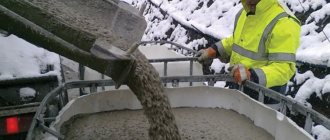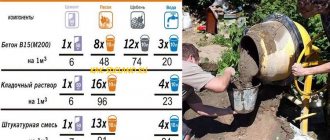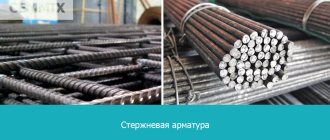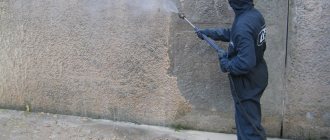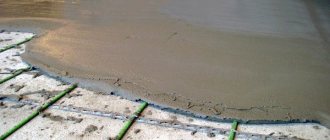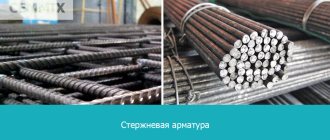Beton-House.com
Website about concrete: construction, characteristics, design. We combine the experience of professionals and private craftsmen in one place
Waterproofing additives in concrete significantly improve the quality of the finished structure
Concrete is very often used in the construction of various parts of buildings. The strength of the entire structure largely depends on how durable this material is and what technical characteristics it will have.
It is in order to improve the performance of a building that additives are used in concrete for waterproofing. The structural porosity of concrete affects its physical properties. How waterproofing additives in concrete improve its quality and which brands should be used will be discussed in our article.
- What are supplements invented for?
Methods for waterproofing concrete
To extend the performance of the material, builders use two methods:
- Waterproofing of concrete structure surfaces is carried out.
- Additives to concrete for waterproofing are added at the stage of its manufacture.
The first option falls into the category of short-lived ones, because insulating materials themselves lose their characteristics over time, decompose and fail. However, they are not cheap, and the process of applying them requires time and financial costs.
Waterproofing additives are another matter. They are added to the concrete solution at the stage of its production and retain their qualities throughout the life of the concrete products, prolonging it to the maximum.
Waterproofing the basement from the inside from groundwater
Vertical waterproofing is carried out along the basement part of the structure in cases where the walls of the structure are located at the groundwater level and in the absence of a drainage system. Horizontal is implemented on the floor - when the base is placed at the groundwater level.
The choice of work method is made based on the following parameters:
- foundation material, insulation quality;
- precipitation level and groundwater occurrence;
- purpose of the premises;
- presence of drainage systems.
General principles of work:
- if the basement is flooded, the water is pumped out or you need to wait until it goes away on its own;
- the surface is cleaned down to the concrete base.
- cracks must be grooved and cleaned for deeper penetration of waterproofing systems;
- reinforcement fabric secured to the base with dowels will enhance moisture resistance;
- when strengthening the horizontal plane, it is filled with crushed stone and cemented, the insulation extends onto the walls up to 300 mm.
Properties of additives
Water-repellent additives do not fill the pores and cracks of concrete; they create a waterproofing barrier that does not allow water to enter the body of the material. That is, the water resistance indicator of such concrete is at the highest level.
Modern supplements
Firstly, it increases the strength of concrete. The denser it is, the stronger it is. Secondly, its water resistance increases. That is, one additive solves two problems at once.
In essence, these substances act as a plasticizer. When it is added to concrete, the solution becomes mobile. And this is the first sign that the air inside is not becoming trapped. When the solution is compacted, it rises to the surface and leaves it.
Surprisingly, technologies have now been developed that can increase the water-repellent properties of hardened concrete.
Its surface is poured with additives, the same, in turn, penetrate inside and clog all the pores. In this case, the rule applies - the more porous the concrete, the deeper the waterproofing liquids penetrate.
Flaws
A significant disadvantage when adding waterproofing additives to concrete is the increase in the thermal conductivity of the structure. The thing is that the pores in the body of the material are peculiar bubbles in which air is located.
The more air pores, the higher the thermal insulation properties. Their absence or reduction in quantity leads to a decrease in this indicator.
How do water repellents work, and how is the effect achieved?
Waterproofing additives are divided into three main groups:
- Plasticizing. When added to the mixture, they envelop the filler particles and make them more slippery and mobile, or create an electric charge around them, which also increases the mobility of the mixture, making it possible to better lay and compact the solution. The finished concrete becomes more durable, the number of pores and capillaries is significantly reduced, which leads to increased water resistance.
- Polymer. At the same time, they envelop the particles and create an electrical charge. As a result, the concrete becomes especially strong, waterproof and frost-resistant.
- Colmatizing. Apply after the solution has hardened. Additives are applied to concrete surfaces and penetrate into the pores. By reacting with concrete, the additives form strong water-repellent compounds that are resistant to aggressive environments.
Read the article about plasticizers
Domestic analogue
Its use in concrete solutions makes it possible to increase the latter’s water permeability indicator to W16. The number shows the pressure in kgf/cm² at which water cannot penetrate the concrete body.
Such concrete will withstand a fairly large column of water, for example, the depth of a swimming pool. In addition, the composition increases:
- twice the strength;
- frost resistance for 60 cycles (freezing-thawing).
Kawabanga!
Concrete floor with topping “Crystal” can be used with any plasticizers; when the concrete structure is exposed to water, efflorescence does not form.
How to work correctly with the “Crystal” additive
An aqueous solution of a waterproofing additive is added to the ready-made concrete solution. Proportions: water 1 volume, additive 1.5 volumes. The liquid is added to the concrete gradually, while the work of the concrete mixer is increased by 15 minutes.
The “Crystal” itself is poured into the drum of the concrete mixer before adding water. Mixing is carried out, after which water is added. In this case, it is possible to reduce the amount of cement equal to the volume of the additive. And in this case, the mixing time is increased by 15 minutes.
Regardless of what brand of concrete will be made, it is recommended to pour 4 kg of waterproofing additive per 1 m³ of solution.
Additives for cement mortar and concrete
Most often, special additives are used in construction to increase the strength of highly loaded concrete structures. Hydrophobic compounds that improve frost resistance are popular. Basically, they are added directly to the mixed concrete mortar, which is used immediately after preparation.
After the setting and hardening processes are completed, solutions with additives demonstrate additional performance characteristics - resistance to corrosion, sub-zero temperatures, water, increased bending/compressive strength, etc. The use of additives is advisable in certain situations, taking into account the high price of concrete and mortar with additives mixed into it.
The use of cement additives is relevant:
- In the production of highly loaded reinforced concrete products, these can be foundation blocks, for example
- If concrete has increased requirements for resistance to water/frost
- When materials of non-standard fractions are chosen as a filler - fine sand, for example
- If there is a need to mix fine-grained concrete mortar
- In the construction of monolithic structures and buildings where expanding additives are used
Liquid additives
Recently, liquid additives for concrete have appeared on the market, which increase its waterproofing characteristics. For example, "Dehydrol". Its effect is the same as that of dry powders. But unlike the latter, it is easy to use.
Firstly, the liquid is supplied in a special container. These are 1000 liter containers. Secondly, it does not require scales. It is enough to measure the liquid in any small container. At least in a glass jar.
Thirdly, the liquid is immediately added to the solution without first mixing with water. Fourthly, there are completely no undissolved particles, which often happens with dry mixtures.
Advantages and disadvantages of use
Earlier we mentioned means of external insulation of concrete products. The basic principle of this method is to create a waterproof shell on the surface. Of course, this avoids the penetration of water into the product in principle. But it's not that simple. Since the product is applied only to the surface, over time it becomes thinner and wears off completely, and re-coating will be problematic.
The primary coating, it must be said, is also not simple. Coating finished products takes quite a lot of time and effort. In addition, such funds are quite expensive. That is why the choice of experienced builders most often falls on additive mixtures.
They have several advantages: • low cost of the product; • ease of use; • durability; • increases the quality of the product; • does not require re-application; • saves time and effort; • there is an opportunity to do it yourself.
As you can see, there are more than enough advantages. But, sad as it may be, there are always shortcomings. The main thing is that they do not outweigh the benefits.
The main and only significant drawback is the increase in thermal conductivity of the material. It is the air bubbles that prevent the rapid movement of heat through the material. Therefore, be prepared for the fact that your concrete path, although it will serve you for a long time, will get very hot in the sun.
Why is concrete waterproofing necessary?
Corrosion of concrete structures occurs due to aggressive external influences, such as:
- temperature changes (freeze-thaw cycles);
- high level of air humidity;
- atmospheric compounds (sulfates, chlorides, carbonates);
- chemicals (alkalis, acids);
- direct contact with water.
Types of waterproofing materials
Materials for sealing a concrete pool can be purchased in stores if funds are available. The most popular and durable:
- PVC film.
- Liquid rubber.
- Liquid glass.
- Latex membrane.
- Polymerizing impregnations
PVC pool film has good waterproofing properties. The main thing is to apply the film correctly to the concrete base, without folds, cracks, gaps, etc. Characteristics of PVC film:
- easy to clean,
- not exposed to temperature changes,
- frost-resistant,
- resistant to high temperatures.
It is advisable to place geotextiles under the film to prevent the formation of condensation and increase resistance to mechanical external influences. The film itself is also a kind of sealant for the pool; it does not allow moisture to pass through and is not susceptible to the pressure of a large volume of water.
As a rule, liquid rubber is used to cover cracks and crevices; this solution protects well from corrosion, but is susceptible to ultraviolet rays. Therefore, a layer of liquid glass is placed on top. The main condition for application is a dry surface.
When the latex mixture dries, it turns into an elastic film that firmly resists fungal infections and bacteria.
Sealing methods can be coating, with leaks into crevices and cracks, applied to the surface in several layers.
Areas of application of concrete with waterproofing additives
Construction mortars with chemical additives are used in the construction of objects operating in conditions of high humidity or in direct contact with water. This:
Using waterproofing additives in concrete, you can prepare your own mortar. To do this you need:
Place dry cement and chemical additives for concrete in the container in the proportions indicated on the additive packaging.
Mix the ingredients, gradually adding water.
Important: prepare such a volume of solution that can be used within 5–10 minutes, otherwise the mixture will lose mobility and become unsuitable for further use.
How to properly dilute
The quality of the composition and ease of application depend on correct mixing. The volume of additives should not exceed the main substance, so professionals recommend maintaining precise proportions. Let's look at the main methods of diluting materials.
Technology for PVA
The glue breaks down when exposed to sunlight. In order not to lose properties, the connection is carried out indoors. The maximum concentration of additives is 20%. When tiling, the ratio of PVA and cement is maintained in proportions of 1 to 5, for plastering work - 1 to 3. If a mortar is prepared for screed, the proportion of adhesive varies between 5-10%.
Concrete is combined with sand and diluted with cold liquid. The additive is added to the composition in the required concentration. The glue has a very viscous consistency, which makes mixing difficult. PVA is first diluted with water to a milky state (1:2), after which it is poured into the solution.
Mixing technology Source domwine.ru
Why are plasticizing additives needed?
To a beginner in construction, it may seem that the concrete mixture does not need to increase its plasticity. Pour in more water, and the concrete without any additives will become liquid and easy to lay. In fact, excess water is the enemy of concrete.
Plasticizers for concrete are the most popular types of additives. By reducing the adhesive force of the particles of the original mixture, they protect it from delamination. Using such additives, it is possible to fill the injection mold and thin-walled foundation formwork without a vibrator.
Another positive effect of using plasticizers is cement savings. By reducing the water content in concrete, it is possible to proportionally reduce the mass fraction of cement without disturbing the “water-cement balance”.
The need for waterproofing
Figure 1. Use of concrete admixtures for waterproofing
Operating principle
Some additives for concrete act differently: by covering the walls of the smallest pores in the material with products formed as a result of the reaction, they create a durable protective layer that pushes out liquid.
Kawabanga! Concrete cleaning products
Advantages and disadvantages
- reducing the amount of work, which in turn helps reduce costs;
- extends service life;
- simple and easy to use;
- improve performance.
Thus, adding mixtures to concrete can increase water resistance, frost resistance and strength.
Among the disadvantages of impurities are:
- increasing the thermal conductivity of the block;
- low adhesion after using additives;
- poor compatibility with certain additives.
Features of additives for waterproofing
Water-repellent additives are added to the solution to fill voids and displace air . This compacts the concrete and increases its resistance to moisture. The strength properties of the material do not deteriorate.
Such additives typically consist of ferric chloride, silicate glue and calcium nitrate. You can also use the following as additives to improve waterproofing
- salt derivatives of naphthenic acids;
- calcium salts;
- paraffin;
- octadecanoic acid.
After adding additives, a chemical reaction occurs in the solution, changing its structure. In fact, all these substances are mechanical impurities, the key task of which is to increase moisture-proofing characteristics.
- alkoxysilanes;
- potassium alkylsilicane;
- hydrocontaining siloxanes.
How to make and how to increase the moisture resistance of a concrete mixture with your own hands
Waterproofing additives in non-shrinkable concrete can increase the moisture resistance of the material without high costs. The method is indispensable when constructing structures exposed to increased moisture (swimming pools, dams, buildings built in areas with shallow groundwater). There are a large number of additives, all of them differ in certain properties. Read about ceramic brick and stone according to GOST 530 here. Properties of additives:
- extending the service life of concrete structures;
- saving money;
- improving the quality of construction work.
Water-repellent putties and plasticizers
A plasticizer is a substance based on lingosulfate salts. The mechanism of action of the additive is to increase the fluidity of the solution; as a result, air bubbles are not retained in the solution, but come out of it freely. The principle is based on the formation of an internal charge or film formation. Plasticizers should be added in portions to the composition when preparing concrete mortar. An important role is played by compliance with the dosage indicated in the instructions. The technology requires constant stirring of the solution; the procedure should be carried out at temperatures above 0. This material will tell you about larch decking boards.
Plasticizers are included in almost all concrete mortars, which is explained by the following advantages:
- increasing the plasticity of the concrete mixture, which ensures ease of laying, concrete gets into all hard-to-reach areas;
- reduction in mixture consumption - reaches 14-17%;
- increasing the strength of concrete—up to 25%;
- no need for compaction using a vibrator;
- adhesive properties, the possibility of using the solution when pouring objects with reinforced areas;
- frost resistance, resistance to cracking.
The use of plasticizers has a negative impact on the hardening time of the solution. In some cases, special hardening accelerators are added to the mixture to shorten the process.
Colmatizing
The properties and mechanism of action of bridging additives are almost identical to plasticizers. As a result of a chemical reaction between the components of the concrete sand-cement mixture and micromnesim, reliable insoluble compounds are formed that fill the voids in the solution. The method of application is the same as when introducing plasticizers.
Price – from 37 rub. for 1 kg.
Benefits of supplements:
- savings on the arrangement of external insulation;
- increasing the moisture resistance of concrete;
- increasing the strength of finished structures.
Penetrating waterproofing
Penetrating waterproofing is applied to the surface of hardened concrete. It is also recommended to add a waterproofing mixture to concrete during the construction of swimming pools, and the dosage should be strictly observed. The composition includes polymer and alkaline components, high-quality Portland cement, and special fillers. The mechanism of action is based on the penetration of the composition into deep layers of concrete. The voids are filled with penetrating waterproofing, which is a barrier to the penetration of moisture into the thickness of the material. Properties of penetrating waterproofing:
- the possibility of using the solution for treating above-ground and underground buildings;
- creation of hermetic seamless coatings on the concrete surface;
- Possibility of use during restoration and repair of buildings;
- prevention of corrosion;
- extending the service life of concrete.
Penetrating waterproofing is recommended to be used in combination with other methods of increasing the moisture resistance of concrete.
Liquid glass for water-based concrete
Liquid glass is a type of silicate adhesive, the use of which has a positive effect on all the properties of concrete. When preparing the solution, it is necessary to add 10% liquid glass to the total mixture. The additive is widely used in the construction of heating boilers, underground reinforced concrete structures, and the construction of foundations. Read about the dimensions of ordinary red brick at this link.
Cost – 786 rub.

